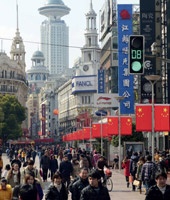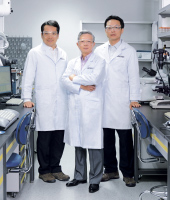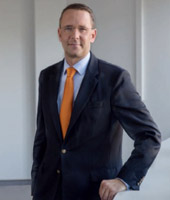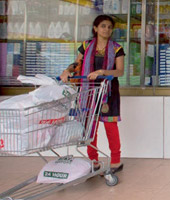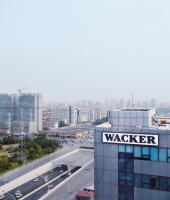The WACKER Group’s Prospects
Our expectations are based on the assumption that the global economy will grow in 2014. For the first time since 2011, Europe’s economy is likely to expand slightly. The strongest growth impetus, though, will come from Asia and the USA.
Our capital expenditures over the next two years will prioritize the completion of our polysilicon production site in Tennessee (USA), which we aim to start up in the second half of 2015. Generally, we are shifting our investment focus toward plants for manufacturing downstream products. WACKER’s priority is to grow its business organically. In our opinion, applications and markets continue to offer good growth potential. As in 2013, capital expenditures will remain below depreciation for the next two years.
WACKER POLYMERS is expanding its production facilities for dispersible polymer powders at Nanjing, China. Annual output there will double from 30,000 to 60,000 metric tons. In 2014, WACKER SILICONES will be investing in plants for downstream products. At Siltronic, capital expenditures are focused on meeting the latest design rules for 300 mm technology.
Future Products and Services
The substitution of styrene-butadiene with WACKER’s VAE dispersions will continue, the main markets being the packaging and carpet sectors. The greatest potential for the substitution business is in the USA and Western Europe. Given that we are already very successful in the USA, we will now intensify our efforts in Europe. The European carpet market is the second-biggest in the world, accounting for 30 percent of the total volume. Both markets combined are worth around US$ 15 billion. We aim to strengthen our market position in the fire-protection coatings segment with a new VINNAPAS® product that provides steel girders in high-rise buildings with superior fire protection. In the event of a fire, intumescent coatings act as an efficient insulating layer that can help save lives. Researchers at Frost & Sullivan expect the market for these coatings to grow to more than US$ 2.5 billion by 2020.
Environmentally friendly interior paints are a rapidly expanding market, particularly in Asia and South America. We aim to profit from further growth in these markets with a new VINNAPAS® dispersion that has been specially developed for such applications. According to the “marketsandmarkets” research institute, the market for environmentally friendly coatings will grow by some 6 percent on average. It already reached a volume of US$ 60 billion in 2012.
WACKER SILICONES plans to intensify its marketing of specialty silicones. In the lighting technology area, we have developed highly transparent liquid silicones for flexible optical lenses. These lenses improve light control in LED lamps. They also pave the way for the development of new, adaptive headlamp systems for cars. According to a McKinsey study, the lighting market will grow to € 100 billion by 2020, with annual growth rates of between 3 and 5 percent.
WACKER SILICONES is supplying new products for cosmetics and personal-care products in Asia. In China and India, we make silicone emulsions for shampoos and conditioners formulated specifically for Asian consumers. Euromonitor estimates that the Asia-Pacific region’s market for cosmetics and personal-care products is growing by over 4 percent annually. Its total volume will reach € 100 billion by 2017. WACKER BIOSOLUTIONS has developed a new binder system under the VINNEX® trademark. The system improves the physical properties of bioplastics and facilitates industrial processing. According to a study compiled by the European Bioplastics association, 1.2 million metric tons of bioplastics were produced in 2011. Production output should climb to around 6 million metric tons by 2016.
Research & Development
The Group’s research and development work remains focused on key strategic projects. In 2014, WACKER intends to spend 20 percent (2013: 20 percent) of its R&D budget on these projects. One major aspect of R&D work in 2014 will be to implement our New Solutions initiative for developing technically and commercially superior solutions for new applications. The R&D budget planned for 2014 amounts to about € 169 million. Our R&D priorities remain the highly promising fields of energy, catalysis, biotechnology, construction applications and semiconductors. We are devoting particular attention to energy storage and renewable energy generation.
In 2014, WACKER will partner with the Technical University of Berlin in organizing an international science convention. The 17th International Symposium on Silicon Chemistry (ISOS XVII) and the jointly organized 7th European Silicon Days are expected to attract as many as 600 researchers from the field of silicon and silicone chemistry to Berlin. During the convention, WACKER will present – for the 14th time – the WACKER Silicone Award for outstanding achievements in this area of research.
Production
WACKER will bring additional production capacity on stream over the next two years. In 2014, WACKER BIOSOLUTIONS will commence operations for PVAc solid resins (annual capacity: 20,000 metric tons) at Nanjing, China. Once that site has met the necessary requirements to qualify for food manufacturing, the old site in Wuxi will close. At Nanjing, we are also planning to expand production capacity for dispersible polymer powders. Current annual capacity there is to rise by 30,000 metric tons to 60,000 metric tons. At WACKER SILICONES, we intend to expand a facility at Burghausen to enable the production of short-chain silicone fluids, vinyl polymers and DEHESIVE® systems for paper coatings. The start-up there is planned for 2015. WACKER POLYSILICON will be commissioning its new polysilicon cleaning plant at the Burghausen site in 2014. During the second half of 2015, polysilicon production is expected to start at the new site in the US state of Tennessee. The Group’s “Wacker Operating System” (WOS) program is focused on further improving productivity, and that involves scrutinizing all the main productivity levers (raw-material and energy efficiency, capacities, and labor productivity). The emphasis is on key projects that have a high economic impact on both costs and benefits.
Facility Start-Ups in 2014 and 2015
| Download XLS |
|
|
||||
|
Location |
Project |
Start-Up |
||
|
|
|
|
||
|
Burghausen |
Polysilicon cleaning plant |
2014 |
||
|
Zhangjiagang |
Emulsion plant |
2014 |
||
|
Burghausen |
Expansion of Silicones 1 |
2014 |
||
|
Nanjing |
Solid resins |
2014 |
||
|
Burghausen |
New steam turbine |
2014 |
||
In 2014, maintenance costs will remain at about € 360 million, the prior-year level.
Procurement and Logistics
Energy and raw-material procurement continues to have an important bearing on WACKER’s profitability. Our energy and raw-material costs account for over one-third of the cost of goods sold. WACKER anticipates that raw-material prices will remain flat, provided the oil price per barrel stays within a corridor of US$ 100 to 110. Our four key raw materials are subject to mixed price trends, even within individual regions. For silicon metal, prices are likely to continue their slight decline in 2014. We expect vinyl-acetate-monomer (VAM) prices to be a little lower in the Americas, but to edge up in Europe. The price of ethylene will remain flat in 2014. We anticipate rising methanol prices over the same period.
On the energy front, the price trend is dominated by regulatory effects. Their influence is greater than any of the market fluctuations on power exchanges. We expect to see electricity-intensive production processes exempted from the German EEG levy in 2014. At the same time, we anticipate substantially higher grid charges and a higher EEG levy for our non-exempted production areas. Energy costs for 2014 will be at the prior-year level.
Supplies of raw materials and energy are secure for the next two years. The markets where we source our raw materials are sufficiently liquid for bottlenecks to be unlikely. We have largely secured the required volumes of our four main raw materials for 2014 and, in most cases, for 2015. We will continue broadening the global reach of WACKER’s portfolio of raw-material suppliers during the coming two years. At the same time, we will keep an even sharper eye on the raw-material purchasing sources that are relevant to us, so that we can access new suppliers.
We have adopted the same approach with technical procurement, where we aim to systematically optimize our supplier portfolio to measurably increase the business value contribution to the company’s success over the next two years. The priority, here, is the targeted expansion of our global procurement network. There are two main areas of focus. According to a policy of “from the region and for the region,” we will systematically scout out suitable local suppliers as WACKER partners for new projects in Asia, primarily China and South Korea. At the same time, we will increase supplies from China, India and South Korea for our sites in the Americas and Europe. These efforts also involve enhancing the IT and communication networks of our international procurement organization. Key areas are the gradual internationalization of work on goods categories and regular information-sharing by the regional purchasing organizations.
On the logistics front, the new public freight terminal (combined road/rail terminal) at Burghausen will open in 2014. Our goal is to use the new terminal to shift more freight from road to rail.
Sales and Marketing
WACKER will increase the number of sales employees in Asia. The aim is to step up our presence and achieve greater market penetration. We have been using the “WACKER on Wheels” pilot project to present our polymer products directly on construction sites in Vietnam, and now plan to extend the approach to other Asian countries, such as Indonesia. Important tradeshows for us in 2014 include in-cosmetics in Hamburg in April and Compamed in Düsseldorf in November. We will be participating in two major tradeshows for coatings and paints: in Dubai in March, and in the USA in April.
Employees
WACKER will adhere to its conservative approach toward hiring new employees. Overall, we estimate that our workforce will grow in 2014 due to the acquisition of Scil Proteins Production in Halle and the consolidation of Siltronic Samsung Wafer Pte. Ltd. We also expect employee numbers to increase in 2015.
In 2014, we will conclude the introduction of a new talent-management process. With it, WACKER aims to promote employee potential across the Group and identify a sufficient number of qualified candidates who can assume challenging tasks in the long term. To improve preventive healthcare for our employees, we are opening a new Health Center at our largest site, Burghausen, in 2014.
We intend to extend the diverse flextime arrangements already in place by introducing four models over the next few years:
- Family-care time, to enable employees to care for relatives
- Reduced full-time employment, available to standard-pay-scale employees over 60 with more demanding jobs
- Sabbaticals, which enable employees to manage their personal working time flexibly by taking a block of time off work
- New qualification programs that offer options for taking advanced training courses either part-time alongside work or full-time while in employment
Sustainability
WACKER is continuing to work on improving its energy efficiency. The planned start of polysilicon production in Tennessee in 2015 will increase our power consumption. We aim to reduce our specific energy consumption (amount of energy per unit of net production output) by 11 percent in Germany by 2022. From 2014 on, we will pursue three quantifiable environmental goals, focused on products, climate protection and emissions. We have therefore selected parameters that are relevant to our production operations: carbon dioxide (CO2) equivalent, non-methane volatile organic compounds (NMVOC s), and particulate matter. We aim to cut our particulate-matter emissions by 25 percent over the next ten years for a comparable product portfolio. We are also striving for a 25 percent reduction in NMVOC emissions. In Germany, we are planning to scale back specific CO2-equivalent emissions by 15 percent per metric ton of net production.
Our 2015 goal for occupational safety is to reduce our groupwide accident rate (the number of workplace accidents per million hours worked) to below 2.0. As part of our efforts toward this goal, we intend to reduce the 2014 accident rate at German sites to below 3.0 per million hours worked.
We are currently preparing a further 160 substance dossiers for the third REACH stage, which runs until mid-2018. We will publish further descriptions of the safe, environmentally compliant use of chemicals (GPS safety summaries) for the substances we have registered with the European Chemicals Agency (ECHA).
